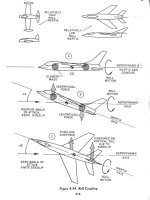Something not generally realized is the considerable internal gyroscopic and inertial forces created by a high RPM spinning of a turbine engine, I would expect a single might be worse than a twin.
Some discussion to counter rotating spools as to an increase in thermodynamic efficiency. In Modern aircraft fly by wire would erase any perceived effects. However in aircraft such as the F104 this might be an important aspect.
As far as large aircraft, neither the 747-400 or the Intercontinental-8 which had very different engines had any noticeable difference in takeoff or power change in my experience with them. By contrast the C-130 did have noticeable if not horrible torque effects.
Interesting!
Gyroscopic effects in jet engines are (apparently) only relevant if the lifting surfaces can't counteract them. With a bit of quick research, even in a Starfighter, there were only very minor gyroscopic effects when accelerating the engine from idle to MIL or back or when at very high altitude (NF-104).
Another thing I found is that the Pegasus in the Harrier has counter-rotating spools to cancel out as much gyroscopic effects as possible to make it easier to keep in a hover.
As for commercial aircraft, the comparatively large lifting and control surfaces in relation to engine dimensions minimize any gyroscopic effects. Not even a GE90 powered 777-300ER should experience notable gyroscopic effects.
As for the C-130, I take that all propellers and engines rotated in the same direction. Add the large props to the equation and you've got sizeable moment arms.
Torque and gyroscopic effects are the reason why the A400M has this horribly complicated setup of counter rotating props on each wing.
And that would be due to the nature of the forces from dual engines balancing themselves out.
No, they don't. Since counter-rotating shafts or engines are more complicated to develop and maintain (due to flow paths and keeping spare part inventories), engines generally only rotate in a single direction, with the exception of applications where torque and gyroscopic effects were absolutely necessary to be minimal (see Harrier and A400M example above).
But as engines became more powerful, you could go with a bigger wing, since the drag was offset by the excess power. In fact, one of the the greatest break troughs in jet engine design in the 50's was the J-79. I don't think a lot of people realize what a game changer that design was, as it's older and we sort of take it for granted now. It ended up being a very bulletproof design.
Eventually, yes. Not sure what the story was for other users or applications, but the Luftwaffe's Starfighter accident rate markedly improved after MTU changed the nozzle actuation system from fuel-driven to hydraulic and implemented an emergency closing system.
Starfighters using the J79-GE-11 sometimes suffered from afterburner malfunctions, leaving the nozzle wide open and subsequently without the necessary thrust to keep flying. With the modification, the emergency closing of the nozzle at least made it convergent enough to recover enough thrust to keep flying and limp home.
I should note that requirements also come into play. For instance, look at the F-104 and the F-11F-1F (I'm glad the Navy finally dropped that designation system!) Super Tiger. Both were double sonic fighter designs, but the F-104 was very unforgiving with it's small wing and t-tail. The West Germans regretted not buying the Super Tiger when they had the chance, but by then it was too late. Granted the F-104 had phenomenal acceleration, and was the only plane that could hang with a Blackbird right after take-off, IIRC. But the Super Tiger was more forgiving and had much lower circuit speeds with it's larger higher aspect ratio wing and was quite maneuverable, in order to meet the U.S. Navy requirements.
Navy requirements don't quite match the requirements of fighter bomber missions over the European continent. Bribery and questionable payload aside, the Luftwaffe wanted fighter bomber and anti shipping capability when they ordered the F-104. One of the Starfighter's virtues is high wing loading and low drag (and the comparatively sophisticated radar), two aspects that made it ideal to get in fast below the OPFOR's radars (low drag), deliver the ordnance without being rattled by every gust of wind (high wing loading).
As a bonus (and bribery aside), the Starfighter was the first multinational jet fighter project due to the Military Assistance Program and being used and produced by various NATO members.
In fact, one of the greatest flight displays I have ever seen was on an Aviation Week video, which isn't on YouTube (Darn), of the X-31 display at the Paris Airshow in the 90's. Granted, it was just an X-Plane, but that was one of the most amazing demonstrations I've ever seen.
Is that a snippet of the demo?
https://www.youtube.com/watch?v=OcArP5bYk6s
Other than that, there's quite a bit of footage from the test flights on Youtube.
Would be cool to have one for flight simming, but it'd need some external module magic to provide3D thrust vectoring capability without outright putting it into the flight dynamics.

